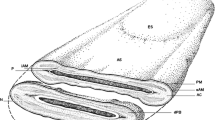Summary
In the human testis the formation of the residual body of the spermatid and its morphological changes during and after spermiation were studied by means of electron microscopy. The caudal cytoplasmic mass of the late spermatid contains a Golgi complex, mitochondria, annulate lamellae, a chromatoid body, flower-like structures, ribosomes, a few large vacuoles, myelin-like membrane profiles and sporadic lipid droplets. When, by detachment of the caudal cytoplasm from the free spermatozoon, the residual body is formed, the chromatoid body has disappeared; the mitochondria are clustered peripherally; the ribosomes appear as a single complex in contact with a large vacuole containing granular material; in place of the Golgi complex aggregations of vesicles are present. The lipid droplets remain unchanged. The residual bodies or their fragments are either extruded via the seminiferous tubular lumen into the excurrent ducts or they are engulfed by Sertoli cells where in the supranuclear region the successive steps of decomposition can be observed. The participation of the various constituents in the disintegration of the residual body is discussed. In contrast to other mammalian species, in man the sporadic lipid droplets seem to be of minor importance in the fate of the residual body.
Similar content being viewed by others
References
Bloom G, Nicander L (1961) On the ultrastructure and development of the protoplasmic droplet of spermatozoa. Z Zellforsch 55:833–844
Brökelmann J (1963) Fine structure of germ cells and Sertoli cells during the cycle of the seminiferous epithelium in the rat. Z Zellforsch 59:820–850
Dietert SE (1966) Fine structure of the formation and fate of the residual bodies of mouse spermatozoa with evidence for the participation of lysosomes. J Morphol 120:317–346
Fawcett DW (1975a) Male reproductive system. In: Bloom W, Fawcett DW (eds) A textbook of histology, 10th ed. Saunders, Philadelphia London Toronto, pp 824–828
Fawcett DW (1975b) Ultrastructure and function of the Sertoli cell. In: Hamilton DW, Greep RO (eds) Male reproductive system. American Physiological Society, Washington DC, pp 21–55 (Handbook of physiology, sect 7, vol 5)
Firlit CF, Davis JR (1965) Morphogenesis of the residual body of the mouse testis. Quart J Micr Sci 106:93–98
Fouquet JP (1974) La spermiation et la formation des corps résiduels chez le hamster: role des cellules de Sertoli. J Microsc 19:161–168
Holstein AF (1976) Ultrastructural observations on the differentiation of spermatids in man. Andrologia 8:157–165
Holstein AF, Roosen-Runge EC (1981) Atlas of human spermatogenesis. Grosse, Berlin
Holstein AF, Schäfer E (1978) A further type of transient cytoplasmic organelles in human spermatids. Cell Tissue Res 192:359–361
Kerr JB, de Kretser DM (1974) The role of the Sertoli cell in phagocytosis of the residual bodies of spermatids. J Reprod Fertil 36:439–440
Kerr JB, de Kretser DM (1975) Cyclic variations in Sertoli cell lipid content throughout the spermatogenic cycle in the rat. J Reprod Fertil 43:1–8
Kerr JB, Mayberry RA, Irby DC (1984) Morphometric studies on lipid inclusions in Sertoli cells during the spermatogenic cycle in the rat. Cell Tissue Res 236:699–709
Kingsley Smith BV, Lacy D (1959) Residual bodies of seminiferous tubules of the rat. Nature 184:249–251
Lacy D (1960) Light and electron microscopy and its use in the study of factors influencing spermatogenesis in the rat. J Roy Micr Soc 79:209–225
Niemi M, Kormano M (1965) Cyclical changes in and significance of lipids and acid phosphatase activity in the seminiferous tubules of the rat testis. Anat Rec 151:159–170
Regaud C (1901) Études sur la structure des tubes séminifères et sur la spermatogenèse chez les mammifères. Arch Anat Micr Morphol Exp 4:101–156
Retzius G (1909) Die Spermien des Menschen. Biologische Untersuchungen, Neue Folge XIV, 20. Fischer, Jena, pp 205–216
Russell LR (1984) Spermiation — the sperm release process: Ultrastructural observations and unresolved problems. In: Van Blerkom J, Motta PM (eds) Ultrastructure of reproduction. Gametogenesis, fertilization, and embryogenesis. Nijhoff, Boston The Hague Dordrecht Lancaster, pp 46–66
Sapsford CS, Rae CA, Cleland KW (1969) The fate of residual bodies and degenerating germ cells and the lipid cycle in Sertoli cells in the bandicoot Perameles nasuta Geoffroy (Marsupialia). Aust J Zool 17:729–753
Schulze C (1974) On the morphology of the human Sertoli cell. Cell Tissue Res 153:339–355
Schulze C (1984) Sertoli cells and Leydig cells in man. In: Beck F, Hild W, Ortmann R, Pauly JE, Schiebler TH (eds) Advances in anatomy, embryology and cell biology, vol 88. Springer, Berlin Heidelberg New York Tokyo
Wartenberg H, Holstein AF (1975) Morphology of the “spindle-shaped body” in the developing tail of human spermatids. Cell Tissue Res 159:435–443
Author information
Authors and Affiliations
Rights and permissions
About this article
Cite this article
Breucker, H., Schäfer, E. & Holstein, AF. Morphogenesis and fate of the residual body in human spermiogenesis. Cell Tissue Res. 240, 303–309 (1985). https://doi.org/10.1007/BF00222339
Accepted:
Issue Date:
DOI: https://doi.org/10.1007/BF00222339




